Management Accounting Report: Cost Analysis and Ethical Issues
VerifiedAdded on 2023/01/05
|16
|2831
|53
Report
AI Summary
This report offers a comprehensive analysis of management accounting, encompassing various aspects such as cost allocation, job costing, process costing, and Cost-Volume-Profit (CVP) analysis. It delves into different cost allocation methods including direct, step-down, and reciprocal methods, and applies these to practical scenarios. The report also explores process costing using both weighted-average and FIFO methods, and performs break-even analysis. Furthermore, the report examines ethical conflicts within the context of operational budgeting, specifically the challenges a sales manager faces when providing sales estimates. The report includes calculations, theoretical concepts, and a case study to review ethical issues in the field of management accounting.

Management accounting
Paraphrase This Document
Need a fresh take? Get an instant paraphrase of this document with our AI Paraphraser
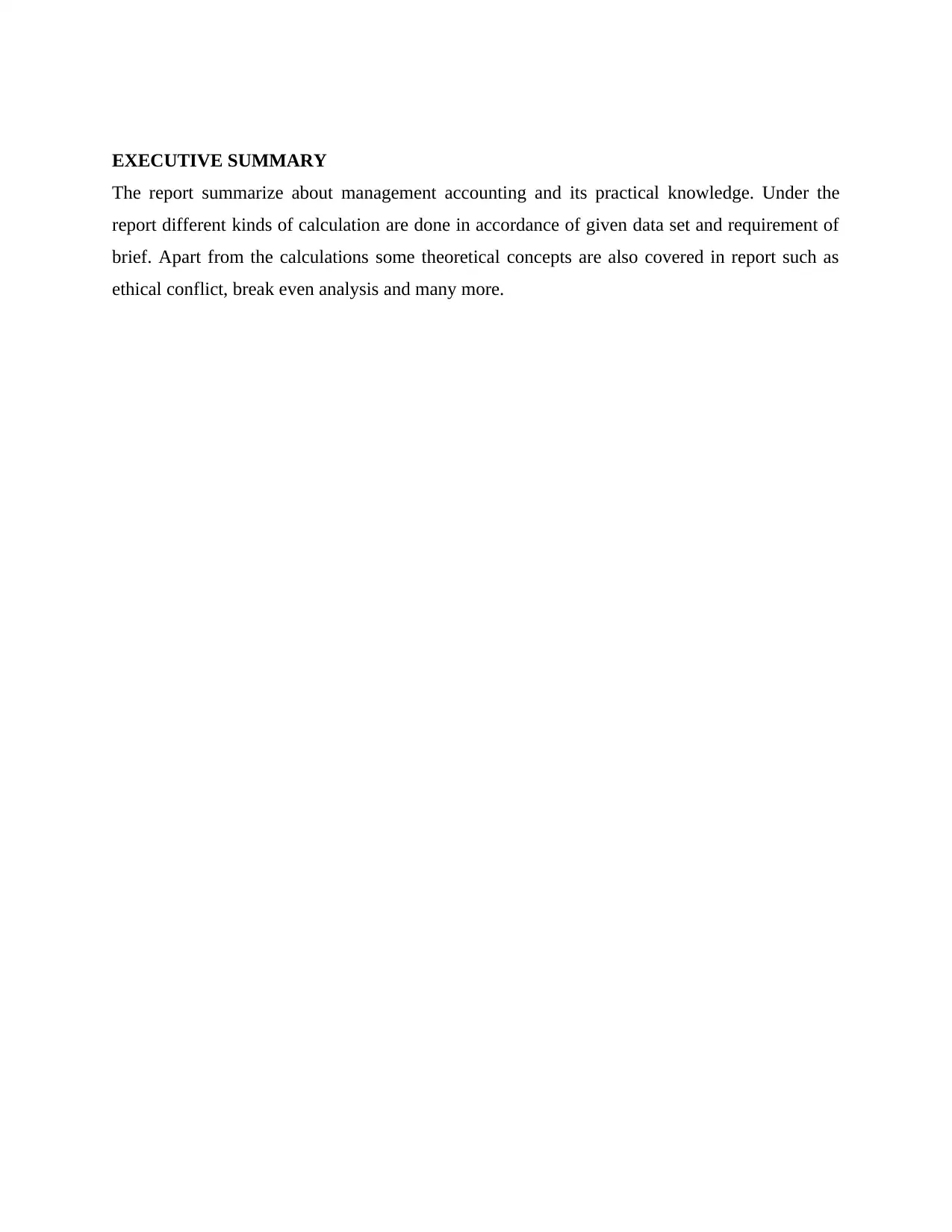
EXECUTIVE SUMMARY
The report summarize about management accounting and its practical knowledge. Under the
report different kinds of calculation are done in accordance of given data set and requirement of
brief. Apart from the calculations some theoretical concepts are also covered in report such as
ethical conflict, break even analysis and many more.
The report summarize about management accounting and its practical knowledge. Under the
report different kinds of calculation are done in accordance of given data set and requirement of
brief. Apart from the calculations some theoretical concepts are also covered in report such as
ethical conflict, break even analysis and many more.
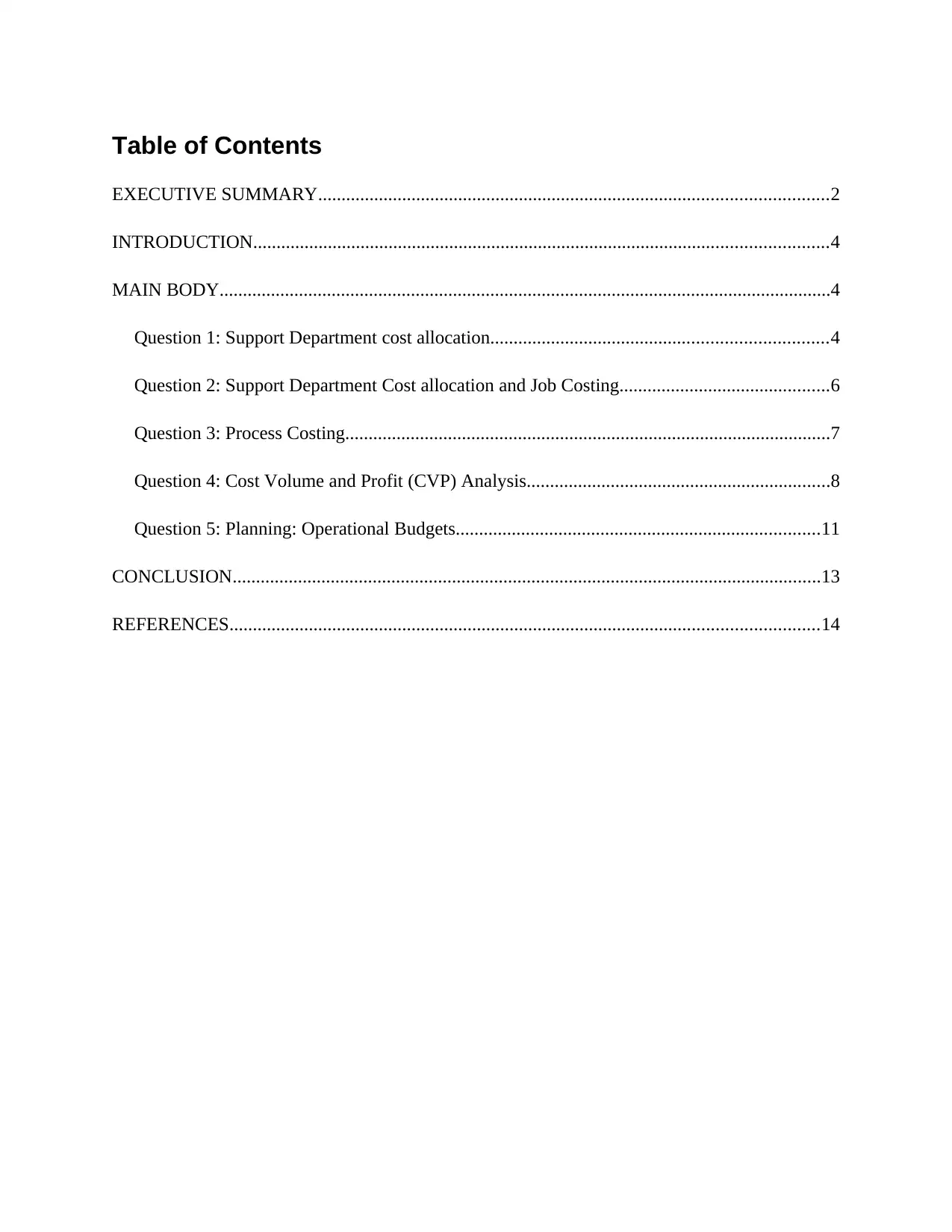
Table of Contents
EXECUTIVE SUMMARY.............................................................................................................2
INTRODUCTION...........................................................................................................................4
MAIN BODY...................................................................................................................................4
Question 1: Support Department cost allocation........................................................................4
Question 2: Support Department Cost allocation and Job Costing.............................................6
Question 3: Process Costing........................................................................................................7
Question 4: Cost Volume and Profit (CVP) Analysis.................................................................8
Question 5: Planning: Operational Budgets..............................................................................11
CONCLUSION..............................................................................................................................13
REFERENCES..............................................................................................................................14
EXECUTIVE SUMMARY.............................................................................................................2
INTRODUCTION...........................................................................................................................4
MAIN BODY...................................................................................................................................4
Question 1: Support Department cost allocation........................................................................4
Question 2: Support Department Cost allocation and Job Costing.............................................6
Question 3: Process Costing........................................................................................................7
Question 4: Cost Volume and Profit (CVP) Analysis.................................................................8
Question 5: Planning: Operational Budgets..............................................................................11
CONCLUSION..............................................................................................................................13
REFERENCES..............................................................................................................................14
⊘ This is a preview!⊘
Do you want full access?
Subscribe today to unlock all pages.

Trusted by 1+ million students worldwide
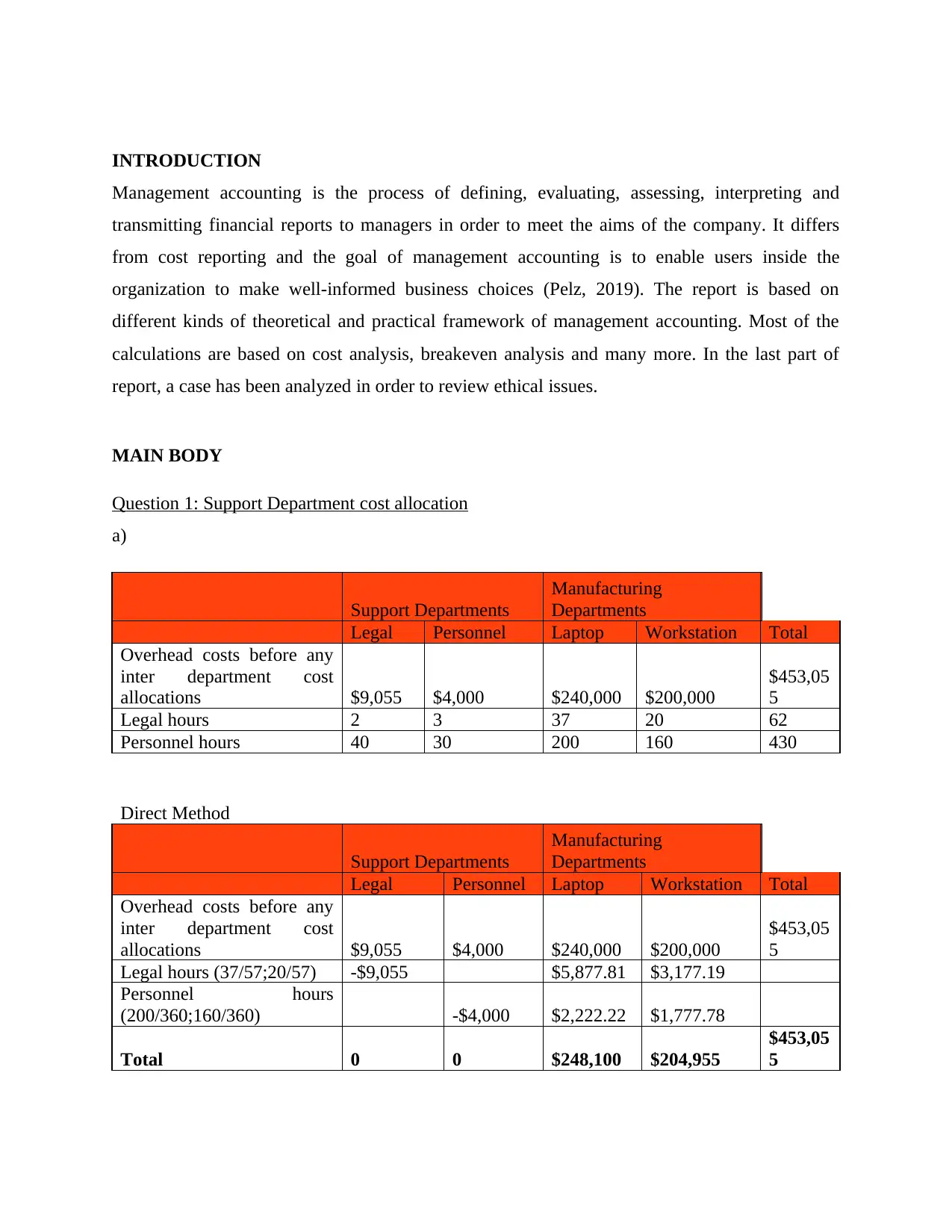
INTRODUCTION
Management accounting is the process of defining, evaluating, assessing, interpreting and
transmitting financial reports to managers in order to meet the aims of the company. It differs
from cost reporting and the goal of management accounting is to enable users inside the
organization to make well-informed business choices (Pelz, 2019). The report is based on
different kinds of theoretical and practical framework of management accounting. Most of the
calculations are based on cost analysis, breakeven analysis and many more. In the last part of
report, a case has been analyzed in order to review ethical issues.
MAIN BODY
Question 1: Support Department cost allocation
a)
Support Departments
Manufacturing
Departments
Legal Personnel Laptop Workstation Total
Overhead costs before any
inter department cost
allocations $9,055 $4,000 $240,000 $200,000
$453,05
5
Legal hours 2 3 37 20 62
Personnel hours 40 30 200 160 430
Direct Method
Support Departments
Manufacturing
Departments
Legal Personnel Laptop Workstation Total
Overhead costs before any
inter department cost
allocations $9,055 $4,000 $240,000 $200,000
$453,05
5
Legal hours (37/57;20/57) -$9,055 $5,877.81 $3,177.19
Personnel hours
(200/360;160/360) -$4,000 $2,222.22 $1,777.78
Total 0 0 $248,100 $204,955
$453,05
5
Management accounting is the process of defining, evaluating, assessing, interpreting and
transmitting financial reports to managers in order to meet the aims of the company. It differs
from cost reporting and the goal of management accounting is to enable users inside the
organization to make well-informed business choices (Pelz, 2019). The report is based on
different kinds of theoretical and practical framework of management accounting. Most of the
calculations are based on cost analysis, breakeven analysis and many more. In the last part of
report, a case has been analyzed in order to review ethical issues.
MAIN BODY
Question 1: Support Department cost allocation
a)
Support Departments
Manufacturing
Departments
Legal Personnel Laptop Workstation Total
Overhead costs before any
inter department cost
allocations $9,055 $4,000 $240,000 $200,000
$453,05
5
Legal hours 2 3 37 20 62
Personnel hours 40 30 200 160 430
Direct Method
Support Departments
Manufacturing
Departments
Legal Personnel Laptop Workstation Total
Overhead costs before any
inter department cost
allocations $9,055 $4,000 $240,000 $200,000
$453,05
5
Legal hours (37/57;20/57) -$9,055 $5,877.81 $3,177.19
Personnel hours
(200/360;160/360) -$4,000 $2,222.22 $1,777.78
Total 0 0 $248,100 $204,955
$453,05
5
Paraphrase This Document
Need a fresh take? Get an instant paraphrase of this document with our AI Paraphraser
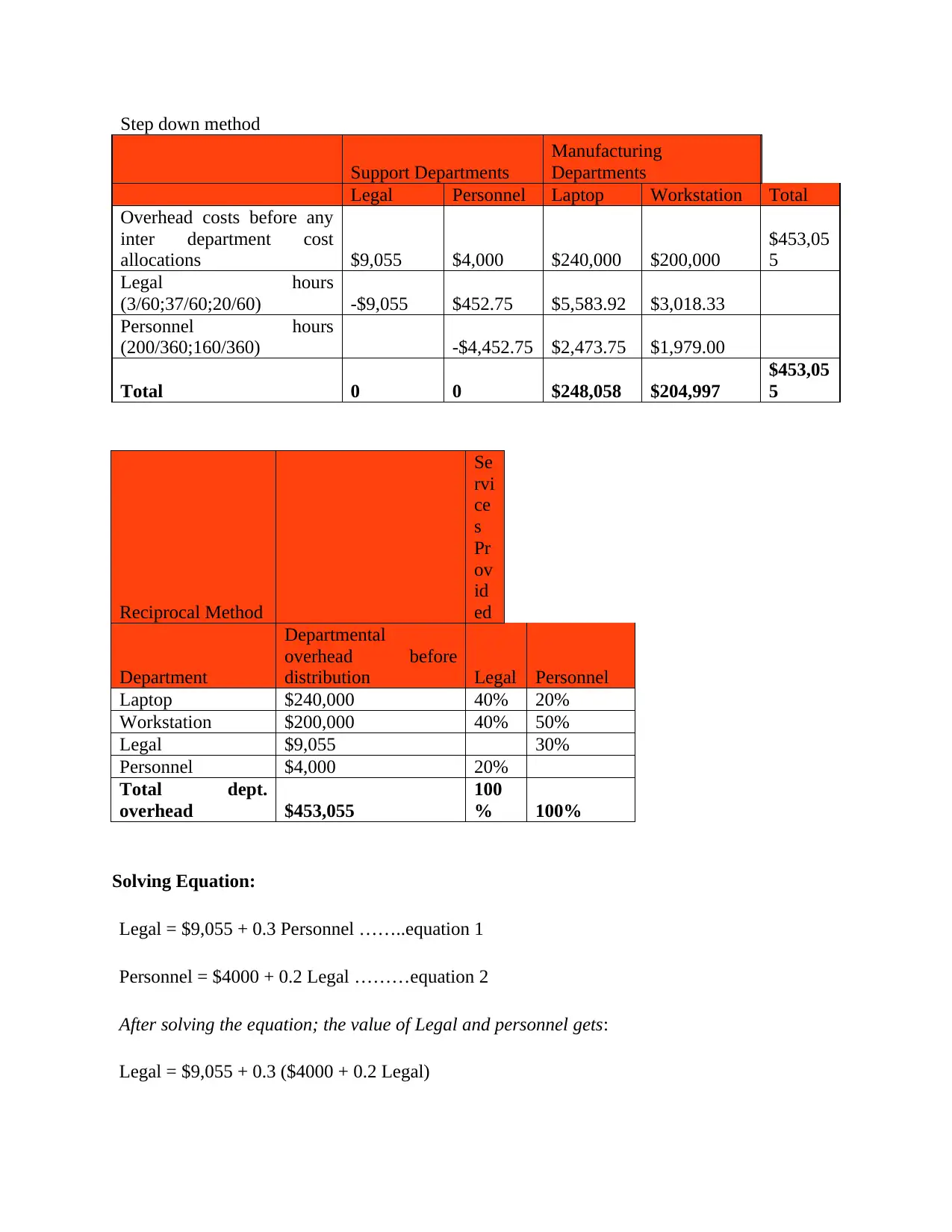
Step down method
Support Departments
Manufacturing
Departments
Legal Personnel Laptop Workstation Total
Overhead costs before any
inter department cost
allocations $9,055 $4,000 $240,000 $200,000
$453,05
5
Legal hours
(3/60;37/60;20/60) -$9,055 $452.75 $5,583.92 $3,018.33
Personnel hours
(200/360;160/360) -$4,452.75 $2,473.75 $1,979.00
Total 0 0 $248,058 $204,997
$453,05
5
Reciprocal Method
Se
rvi
ce
s
Pr
ov
id
ed
Department
Departmental
overhead before
distribution Legal Personnel
Laptop $240,000 40% 20%
Workstation $200,000 40% 50%
Legal $9,055 30%
Personnel $4,000 20%
Total dept.
overhead $453,055
100
% 100%
Solving Equation:
Legal = $9,055 + 0.3 Personnel ……..equation 1
Personnel = $4000 + 0.2 Legal ………equation 2
After solving the equation; the value of Legal and personnel gets:
Legal = $9,055 + 0.3 ($4000 + 0.2 Legal)
Support Departments
Manufacturing
Departments
Legal Personnel Laptop Workstation Total
Overhead costs before any
inter department cost
allocations $9,055 $4,000 $240,000 $200,000
$453,05
5
Legal hours
(3/60;37/60;20/60) -$9,055 $452.75 $5,583.92 $3,018.33
Personnel hours
(200/360;160/360) -$4,452.75 $2,473.75 $1,979.00
Total 0 0 $248,058 $204,997
$453,05
5
Reciprocal Method
Se
rvi
ce
s
Pr
ov
id
ed
Department
Departmental
overhead before
distribution Legal Personnel
Laptop $240,000 40% 20%
Workstation $200,000 40% 50%
Legal $9,055 30%
Personnel $4,000 20%
Total dept.
overhead $453,055
100
% 100%
Solving Equation:
Legal = $9,055 + 0.3 Personnel ……..equation 1
Personnel = $4000 + 0.2 Legal ………equation 2
After solving the equation; the value of Legal and personnel gets:
Legal = $9,055 + 0.3 ($4000 + 0.2 Legal)
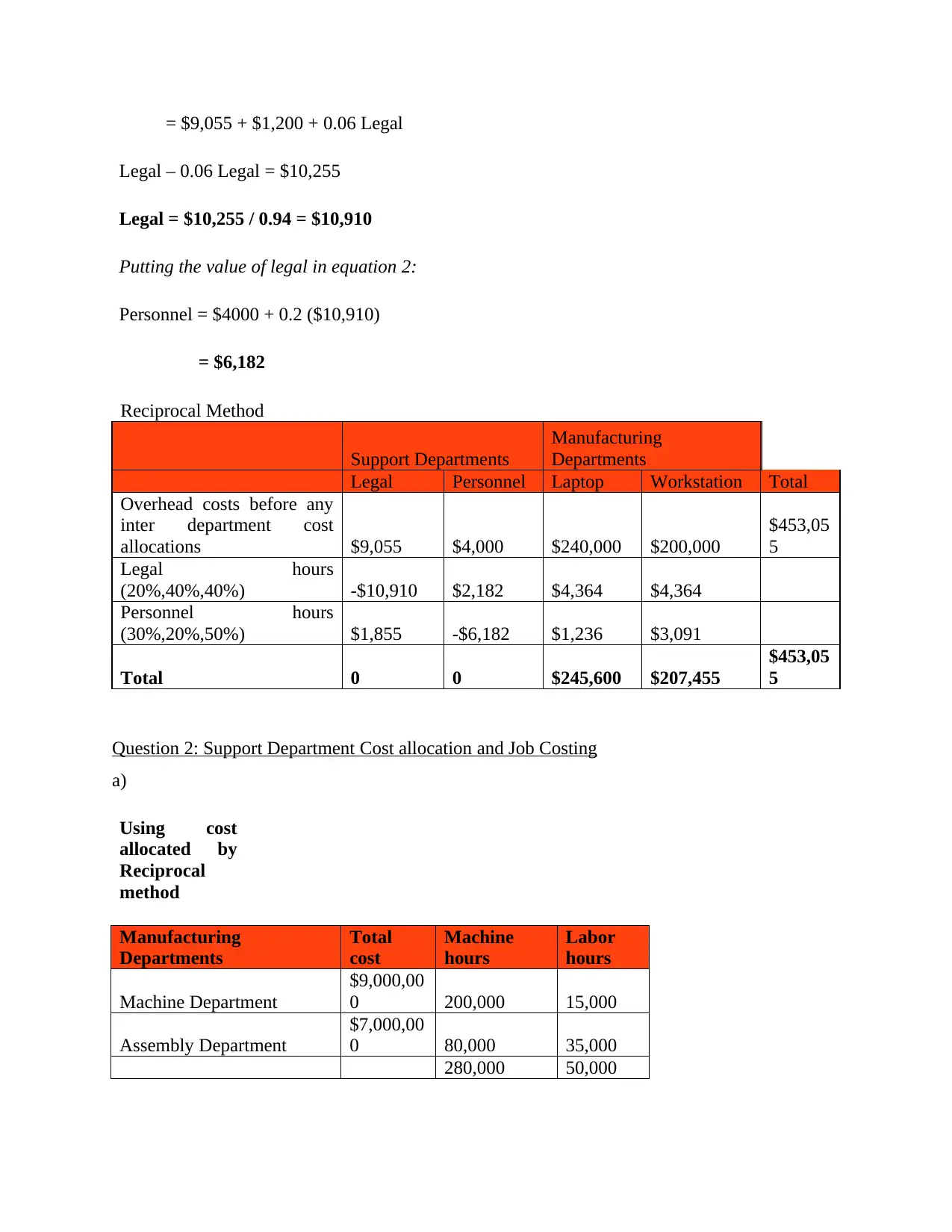
= $9,055 + $1,200 + 0.06 Legal
Legal – 0.06 Legal = $10,255
Legal = $10,255 / 0.94 = $10,910
Putting the value of legal in equation 2:
Personnel = $4000 + 0.2 ($10,910)
= $6,182
Reciprocal Method
Support Departments
Manufacturing
Departments
Legal Personnel Laptop Workstation Total
Overhead costs before any
inter department cost
allocations $9,055 $4,000 $240,000 $200,000
$453,05
5
Legal hours
(20%,40%,40%) -$10,910 $2,182 $4,364 $4,364
Personnel hours
(30%,20%,50%) $1,855 -$6,182 $1,236 $3,091
Total 0 0 $245,600 $207,455
$453,05
5
Question 2: Support Department Cost allocation and Job Costing
a)
Using cost
allocated by
Reciprocal
method
Manufacturing
Departments
Total
cost
Machine
hours
Labor
hours
Machine Department
$9,000,00
0 200,000 15,000
Assembly Department
$7,000,00
0 80,000 35,000
280,000 50,000
Legal – 0.06 Legal = $10,255
Legal = $10,255 / 0.94 = $10,910
Putting the value of legal in equation 2:
Personnel = $4000 + 0.2 ($10,910)
= $6,182
Reciprocal Method
Support Departments
Manufacturing
Departments
Legal Personnel Laptop Workstation Total
Overhead costs before any
inter department cost
allocations $9,055 $4,000 $240,000 $200,000
$453,05
5
Legal hours
(20%,40%,40%) -$10,910 $2,182 $4,364 $4,364
Personnel hours
(30%,20%,50%) $1,855 -$6,182 $1,236 $3,091
Total 0 0 $245,600 $207,455
$453,05
5
Question 2: Support Department Cost allocation and Job Costing
a)
Using cost
allocated by
Reciprocal
method
Manufacturing
Departments
Total
cost
Machine
hours
Labor
hours
Machine Department
$9,000,00
0 200,000 15,000
Assembly Department
$7,000,00
0 80,000 35,000
280,000 50,000
⊘ This is a preview!⊘
Do you want full access?
Subscribe today to unlock all pages.

Trusted by 1+ million students worldwide
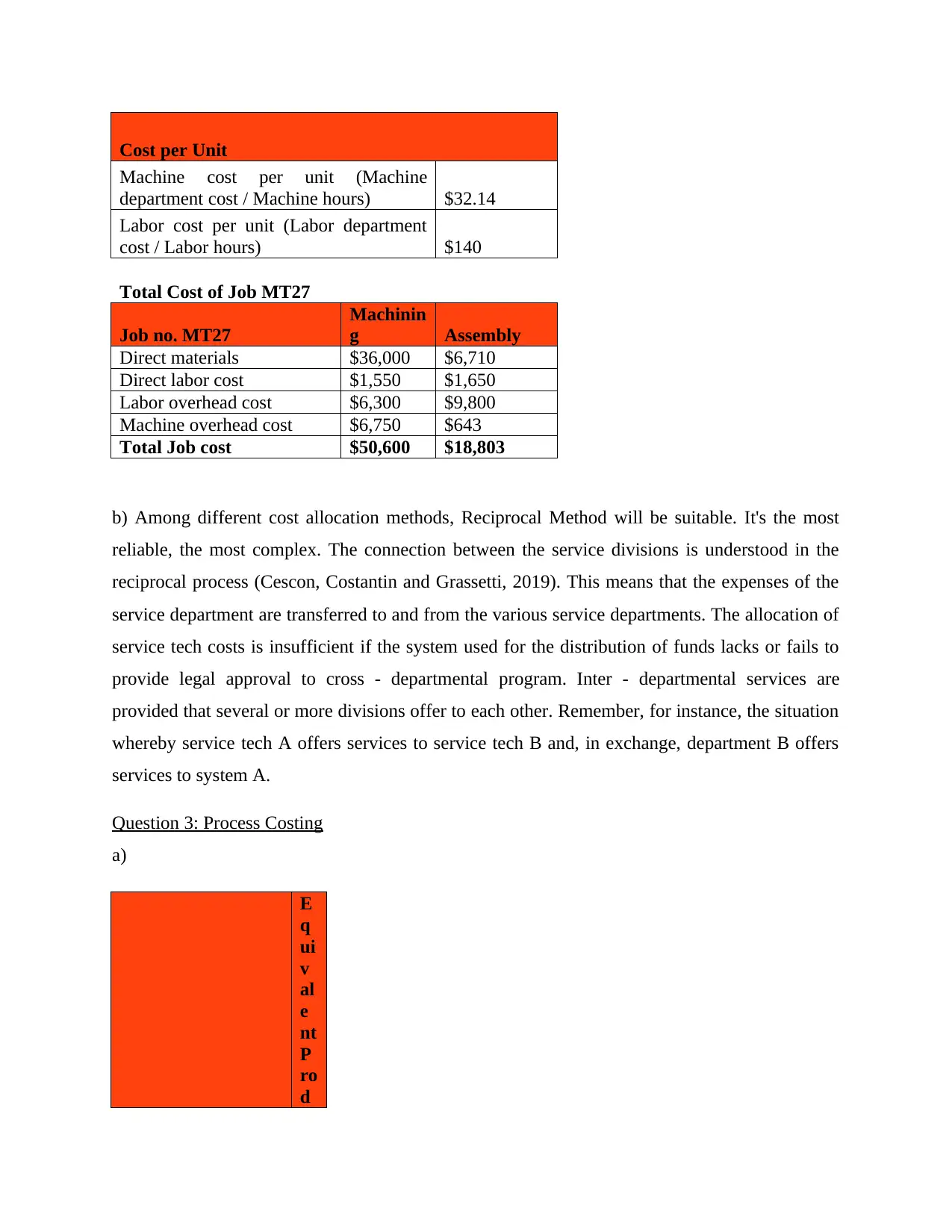
Cost per Unit
Machine cost per unit (Machine
department cost / Machine hours) $32.14
Labor cost per unit (Labor department
cost / Labor hours) $140
Total Cost of Job MT27
Job no. MT27
Machinin
g Assembly
Direct materials $36,000 $6,710
Direct labor cost $1,550 $1,650
Labor overhead cost $6,300 $9,800
Machine overhead cost $6,750 $643
Total Job cost $50,600 $18,803
b) Among different cost allocation methods, Reciprocal Method will be suitable. It's the most
reliable, the most complex. The connection between the service divisions is understood in the
reciprocal process (Cescon, Costantin and Grassetti, 2019). This means that the expenses of the
service department are transferred to and from the various service departments. The allocation of
service tech costs is insufficient if the system used for the distribution of funds lacks or fails to
provide legal approval to cross - departmental program. Inter - departmental services are
provided that several or more divisions offer to each other. Remember, for instance, the situation
whereby service tech A offers services to service tech B and, in exchange, department B offers
services to system A.
Question 3: Process Costing
a)
E
q
ui
v
al
e
nt
P
ro
d
Machine cost per unit (Machine
department cost / Machine hours) $32.14
Labor cost per unit (Labor department
cost / Labor hours) $140
Total Cost of Job MT27
Job no. MT27
Machinin
g Assembly
Direct materials $36,000 $6,710
Direct labor cost $1,550 $1,650
Labor overhead cost $6,300 $9,800
Machine overhead cost $6,750 $643
Total Job cost $50,600 $18,803
b) Among different cost allocation methods, Reciprocal Method will be suitable. It's the most
reliable, the most complex. The connection between the service divisions is understood in the
reciprocal process (Cescon, Costantin and Grassetti, 2019). This means that the expenses of the
service department are transferred to and from the various service departments. The allocation of
service tech costs is insufficient if the system used for the distribution of funds lacks or fails to
provide legal approval to cross - departmental program. Inter - departmental services are
provided that several or more divisions offer to each other. Remember, for instance, the situation
whereby service tech A offers services to service tech B and, in exchange, department B offers
services to system A.
Question 3: Process Costing
a)
E
q
ui
v
al
e
nt
P
ro
d
Paraphrase This Document
Need a fresh take? Get an instant paraphrase of this document with our AI Paraphraser

u
ct
io
n
Material
Production data Output Units % Units % Units
Opening WIP 70,000 70% 49,000 40% 28,000
Units transferred out 380,000 100% 380,000 100% 380,000
Ending WIP 80,000 75% 60,000 25% 20,000
530,000 489,000 428,000
Statement
of cost
Item Amount
Equivalent
Production
Cost per
unit
Material $391,850 489,000 $0.80
Conversion $287,300 428,000 $0.67
Total cost
per unit $1.47
i. Weighted-Average method
Process
A/c FIFO
Method
Weighted-
Average
method
Units
Amoun
t Units
Amou
nt
Beginning
WIP 70,000 $50,050 Process transferred
450,00
0
$662,6
66
Materials
460,00
0
$391,85
0 Ending WIP (Balance) 80,000
$66,53
4
Conversion
$287,30
0
530,00
0
$729,20
0
530,00
0
$729,2
00
ii. FIFO method
ct
io
n
Material
Production data Output Units % Units % Units
Opening WIP 70,000 70% 49,000 40% 28,000
Units transferred out 380,000 100% 380,000 100% 380,000
Ending WIP 80,000 75% 60,000 25% 20,000
530,000 489,000 428,000
Statement
of cost
Item Amount
Equivalent
Production
Cost per
unit
Material $391,850 489,000 $0.80
Conversion $287,300 428,000 $0.67
Total cost
per unit $1.47
i. Weighted-Average method
Process
A/c FIFO
Method
Weighted-
Average
method
Units
Amoun
t Units
Amou
nt
Beginning
WIP 70,000 $50,050 Process transferred
450,00
0
$662,6
66
Materials
460,00
0
$391,85
0 Ending WIP (Balance) 80,000
$66,53
4
Conversion
$287,30
0
530,00
0
$729,20
0
530,00
0
$729,2
00
ii. FIFO method
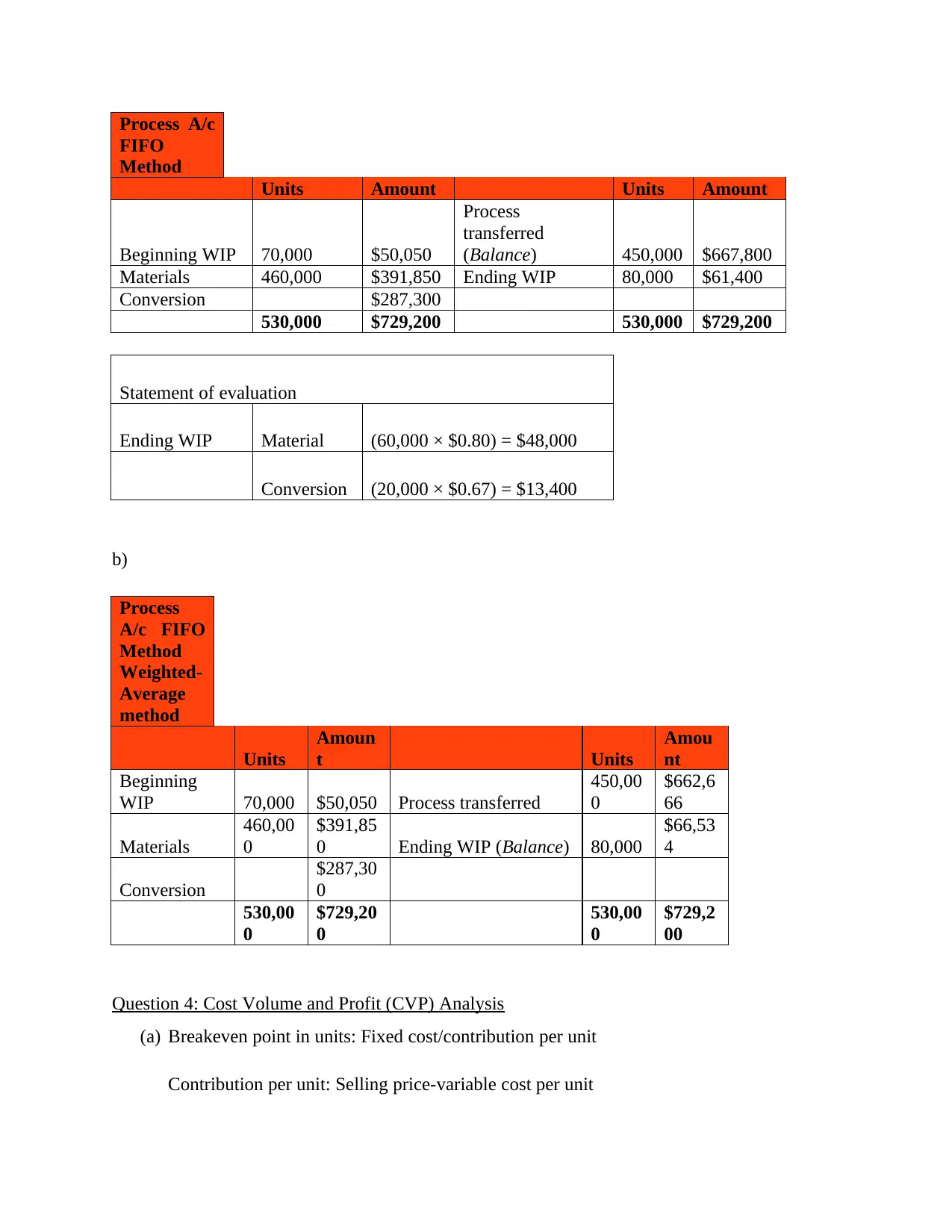
Process A/c
FIFO
Method
Units Amount Units Amount
Beginning WIP 70,000 $50,050
Process
transferred
(Balance) 450,000 $667,800
Materials 460,000 $391,850 Ending WIP 80,000 $61,400
Conversion $287,300
530,000 $729,200 530,000 $729,200
Statement of evaluation
Ending WIP Material (60,000 × $0.80) = $48,000
Conversion (20,000 × $0.67) = $13,400
b)
Process
A/c FIFO
Method
Weighted-
Average
method
Units
Amoun
t Units
Amou
nt
Beginning
WIP 70,000 $50,050 Process transferred
450,00
0
$662,6
66
Materials
460,00
0
$391,85
0 Ending WIP (Balance) 80,000
$66,53
4
Conversion
$287,30
0
530,00
0
$729,20
0
530,00
0
$729,2
00
Question 4: Cost Volume and Profit (CVP) Analysis
(a) Breakeven point in units: Fixed cost/contribution per unit
Contribution per unit: Selling price-variable cost per unit
FIFO
Method
Units Amount Units Amount
Beginning WIP 70,000 $50,050
Process
transferred
(Balance) 450,000 $667,800
Materials 460,000 $391,850 Ending WIP 80,000 $61,400
Conversion $287,300
530,000 $729,200 530,000 $729,200
Statement of evaluation
Ending WIP Material (60,000 × $0.80) = $48,000
Conversion (20,000 × $0.67) = $13,400
b)
Process
A/c FIFO
Method
Weighted-
Average
method
Units
Amoun
t Units
Amou
nt
Beginning
WIP 70,000 $50,050 Process transferred
450,00
0
$662,6
66
Materials
460,00
0
$391,85
0 Ending WIP (Balance) 80,000
$66,53
4
Conversion
$287,30
0
530,00
0
$729,20
0
530,00
0
$729,2
00
Question 4: Cost Volume and Profit (CVP) Analysis
(a) Breakeven point in units: Fixed cost/contribution per unit
Contribution per unit: Selling price-variable cost per unit
⊘ This is a preview!⊘
Do you want full access?
Subscribe today to unlock all pages.

Trusted by 1+ million students worldwide
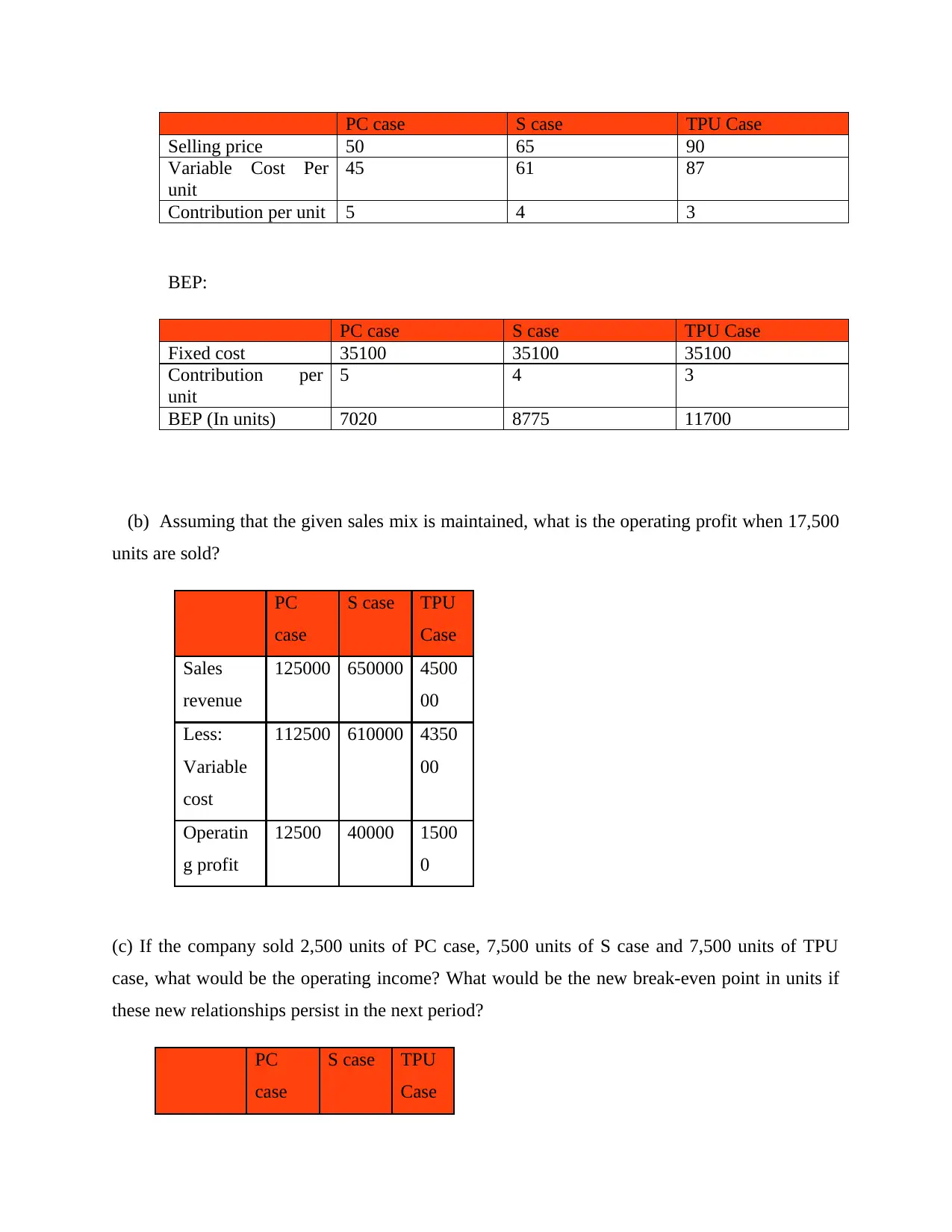
PC case S case TPU Case
Selling price 50 65 90
Variable Cost Per
unit
45 61 87
Contribution per unit 5 4 3
BEP:
PC case S case TPU Case
Fixed cost 35100 35100 35100
Contribution per
unit
5 4 3
BEP (In units) 7020 8775 11700
(b) Assuming that the given sales mix is maintained, what is the operating profit when 17,500
units are sold?
PC
case
S case TPU
Case
Sales
revenue
125000 650000 4500
00
Less:
Variable
cost
112500 610000 4350
00
Operatin
g profit
12500 40000 1500
0
(c) If the company sold 2,500 units of PC case, 7,500 units of S case and 7,500 units of TPU
case, what would be the operating income? What would be the new break-even point in units if
these new relationships persist in the next period?
PC
case
S case TPU
Case
Selling price 50 65 90
Variable Cost Per
unit
45 61 87
Contribution per unit 5 4 3
BEP:
PC case S case TPU Case
Fixed cost 35100 35100 35100
Contribution per
unit
5 4 3
BEP (In units) 7020 8775 11700
(b) Assuming that the given sales mix is maintained, what is the operating profit when 17,500
units are sold?
PC
case
S case TPU
Case
Sales
revenue
125000 650000 4500
00
Less:
Variable
cost
112500 610000 4350
00
Operatin
g profit
12500 40000 1500
0
(c) If the company sold 2,500 units of PC case, 7,500 units of S case and 7,500 units of TPU
case, what would be the operating income? What would be the new break-even point in units if
these new relationships persist in the next period?
PC
case
S case TPU
Case
Paraphrase This Document
Need a fresh take? Get an instant paraphrase of this document with our AI Paraphraser
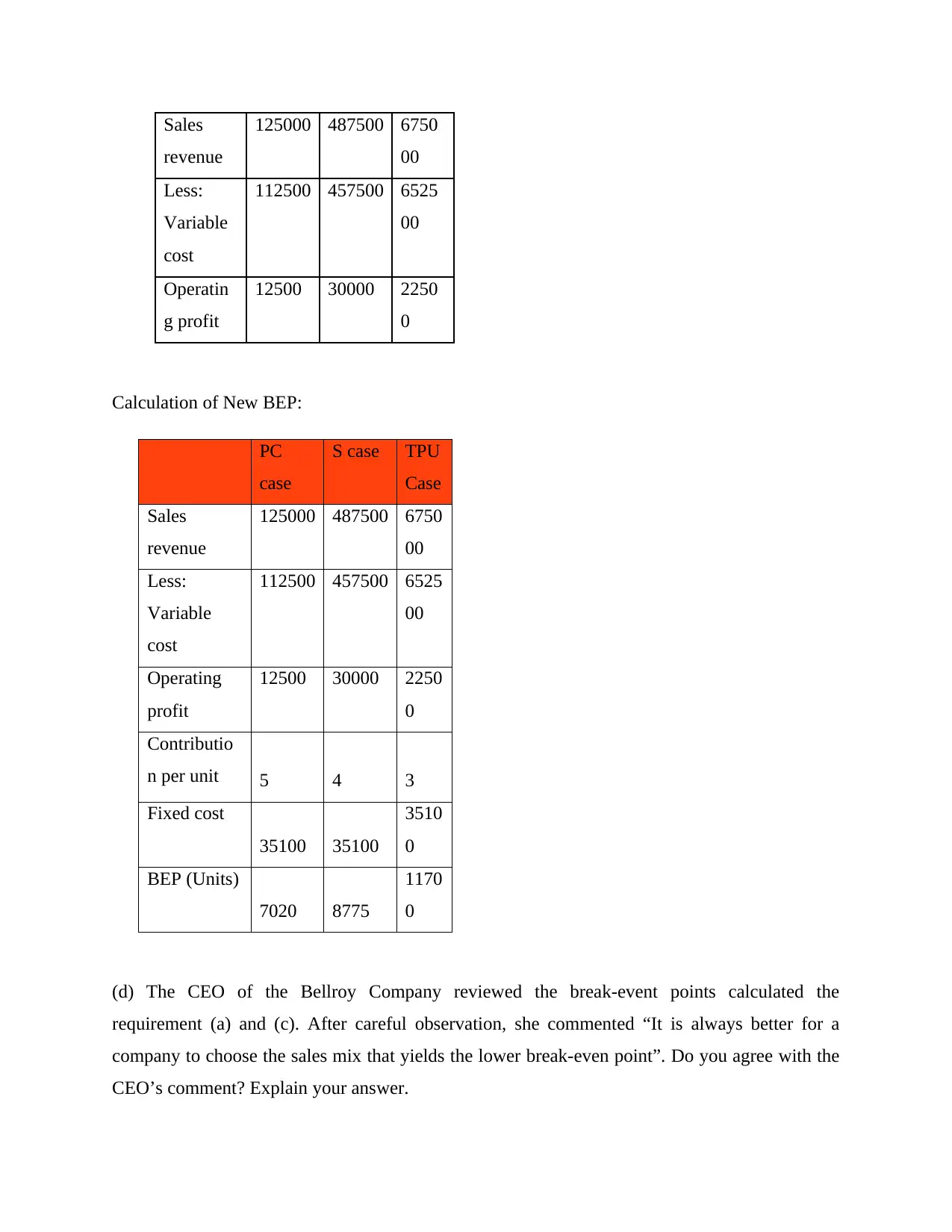
Sales
revenue
125000 487500 6750
00
Less:
Variable
cost
112500 457500 6525
00
Operatin
g profit
12500 30000 2250
0
Calculation of New BEP:
PC
case
S case TPU
Case
Sales
revenue
125000 487500 6750
00
Less:
Variable
cost
112500 457500 6525
00
Operating
profit
12500 30000 2250
0
Contributio
n per unit 5 4 3
Fixed cost
35100 35100
3510
0
BEP (Units)
7020 8775
1170
0
(d) The CEO of the Bellroy Company reviewed the break-event points calculated the
requirement (a) and (c). After careful observation, she commented “It is always better for a
company to choose the sales mix that yields the lower break-even point”. Do you agree with the
CEO’s comment? Explain your answer.
revenue
125000 487500 6750
00
Less:
Variable
cost
112500 457500 6525
00
Operatin
g profit
12500 30000 2250
0
Calculation of New BEP:
PC
case
S case TPU
Case
Sales
revenue
125000 487500 6750
00
Less:
Variable
cost
112500 457500 6525
00
Operating
profit
12500 30000 2250
0
Contributio
n per unit 5 4 3
Fixed cost
35100 35100
3510
0
BEP (Units)
7020 8775
1170
0
(d) The CEO of the Bellroy Company reviewed the break-event points calculated the
requirement (a) and (c). After careful observation, she commented “It is always better for a
company to choose the sales mix that yields the lower break-even point”. Do you agree with the
CEO’s comment? Explain your answer.
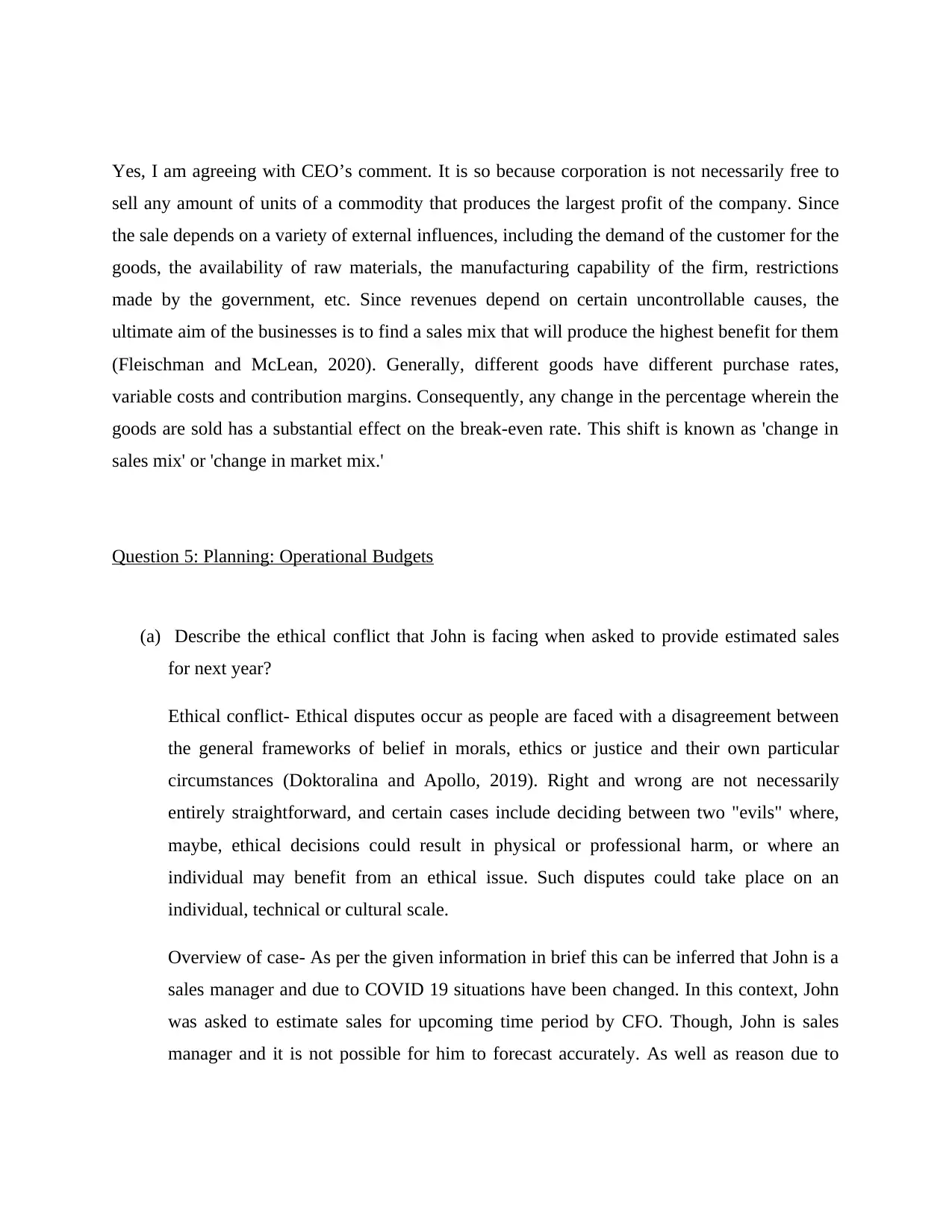
Yes, I am agreeing with CEO’s comment. It is so because corporation is not necessarily free to
sell any amount of units of a commodity that produces the largest profit of the company. Since
the sale depends on a variety of external influences, including the demand of the customer for the
goods, the availability of raw materials, the manufacturing capability of the firm, restrictions
made by the government, etc. Since revenues depend on certain uncontrollable causes, the
ultimate aim of the businesses is to find a sales mix that will produce the highest benefit for them
(Fleischman and McLean, 2020). Generally, different goods have different purchase rates,
variable costs and contribution margins. Consequently, any change in the percentage wherein the
goods are sold has a substantial effect on the break-even rate. This shift is known as 'change in
sales mix' or 'change in market mix.'
Question 5: Planning: Operational Budgets
(a) Describe the ethical conflict that John is facing when asked to provide estimated sales
for next year?
Ethical conflict- Ethical disputes occur as people are faced with a disagreement between
the general frameworks of belief in morals, ethics or justice and their own particular
circumstances (Doktoralina and Apollo, 2019). Right and wrong are not necessarily
entirely straightforward, and certain cases include deciding between two "evils" where,
maybe, ethical decisions could result in physical or professional harm, or where an
individual may benefit from an ethical issue. Such disputes could take place on an
individual, technical or cultural scale.
Overview of case- As per the given information in brief this can be inferred that John is a
sales manager and due to COVID 19 situations have been changed. In this context, John
was asked to estimate sales for upcoming time period by CFO. Though, John is sales
manager and it is not possible for him to forecast accurately. As well as reason due to
sell any amount of units of a commodity that produces the largest profit of the company. Since
the sale depends on a variety of external influences, including the demand of the customer for the
goods, the availability of raw materials, the manufacturing capability of the firm, restrictions
made by the government, etc. Since revenues depend on certain uncontrollable causes, the
ultimate aim of the businesses is to find a sales mix that will produce the highest benefit for them
(Fleischman and McLean, 2020). Generally, different goods have different purchase rates,
variable costs and contribution margins. Consequently, any change in the percentage wherein the
goods are sold has a substantial effect on the break-even rate. This shift is known as 'change in
sales mix' or 'change in market mix.'
Question 5: Planning: Operational Budgets
(a) Describe the ethical conflict that John is facing when asked to provide estimated sales
for next year?
Ethical conflict- Ethical disputes occur as people are faced with a disagreement between
the general frameworks of belief in morals, ethics or justice and their own particular
circumstances (Doktoralina and Apollo, 2019). Right and wrong are not necessarily
entirely straightforward, and certain cases include deciding between two "evils" where,
maybe, ethical decisions could result in physical or professional harm, or where an
individual may benefit from an ethical issue. Such disputes could take place on an
individual, technical or cultural scale.
Overview of case- As per the given information in brief this can be inferred that John is a
sales manager and due to COVID 19 situations have been changed. In this context, John
was asked to estimate sales for upcoming time period by CFO. Though, John is sales
manager and it is not possible for him to forecast accurately. As well as reason due to
⊘ This is a preview!⊘
Do you want full access?
Subscribe today to unlock all pages.

Trusted by 1+ million students worldwide
1 out of 16
Your All-in-One AI-Powered Toolkit for Academic Success.
+13062052269
info@desklib.com
Available 24*7 on WhatsApp / Email
![[object Object]](/_next/static/media/star-bottom.7253800d.svg)
Unlock your academic potential
Copyright © 2020–2025 A2Z Services. All Rights Reserved. Developed and managed by ZUCOL.


